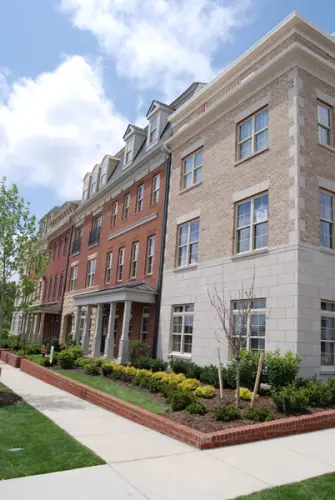
Space is the ultimate American luxury.
Elbow room, manifest destiny, large SUV’s, acreage, privacy, trees … all of these items help us create the luxury we call space. It is somehow American (or perhaps, just plain human nature) to be insular and protected in where we live. We want our homes to back up to trees (or better yet, woods!) and to have places to go and seek asylum within our own homes.
Yet in the same breath, we want to be close to things. Restaurants, coffee shops, quaint boutiques, parks, culture and events … all within a short walk is highly desirable. The ability to walk to the market to get a loaf of bread or to the local cafe where the proprietor greets you by name is also alluring. Being immune to the whims of traffic and the yin and yang of rush hour is empowering in so many ways. We forget sometimes how refreshing it is to walk from point A to point B and thus we think in terms of how quickly can we get to where we are going and not how much we will enjoy the journey.
What is unfortunate is both of these wishes (elbow room versus proximity) largely preclude the other.
It is no secret that the suburban development model allows for more ‘privacy.’ While some lot sizes are small, they are still far larger than the typical urban lot. Many of the the neighborhoods of Richmond have lots as small as 7,000 square feet (SF) such as The Fan, Museum District, Church Hill, Jackson Ward and Manchester. This compares to the 1/3 acre standard in most suburban settings (15,000 – 20,000 SF) with more width and more trees (usually) to give some semblance of privacy.
Ironically, the suburban development model which has been in vogue since the advent of the automobile, has actually taken the one invention designed to connect us (the car) and turned into an instrument which does the exact opposite (traffic.) Our current development practice isolates our uses from one another. Office parks only contain office space. Residential neighborhoods only contain residences. Retail strip centers are constructed in retail or commercial corridors. This isolation of uses only forces us to build more roads and widen our interstates. The result is more and more time lost in traffic and an increased burden on our taxes to pay for more and more infrastructure.
So what is the answer?

New Urbanism may be one. The ‘New Urbanist’ movement has many different interpretations but essentially asks the question – if we could build a city from the ground up, starting today, what would it look like? Richmond is now seeing examples of NU thinking creeping into our new suburban development. The Village at Rocketts Landing and West Broad Village are the two most well known examples of New Urbanism in Richmond. Currently under development is the Libbie Mill project near the Staples Mill/I64 Interchange by Gumenick Properties. However, these projects are dwarfed in size by the potential live/work/play retooling of the Innsbrook Office Park.
The size and scale of Innsbrook (1300 acres,) already home to some of the nicest and most highly occupied suburban low and mid rise office space, makes this a true ‘game-changer’ for Richmond. Libbie Mill is attempting to combine residential, retail and office into one development but its relatively small size (80 acres) prevents it from changing the landscape of Richmond. West Broad Village combines housing and retail (as does Rockett’s, albeit on a far less successful scale) but they both lack the office component. Residents of West Broad Village and Rocketts still generally need to drive to and from work, while Innsbrook will offer the potential for someone to exist almost wholly within the development. Being able to live, work AND play in the same development or neighborhood does not really exist anywhere in Richmond on any scale, even within the oldest neighborhoods of the City.
And while a true 1/3 acre suburban lot may not be available in Innsbrook, the greens spaces provided may lessen the impact of the density and the mix of retail, residential AND office will be a powerful draw. Will we see the demise of the suburban planned neighborhood? Not likely, but we are on the leading edge of seeing more instances of all property types in closer proximity to one another to hopefully shorten the distance between space, services and employment.





